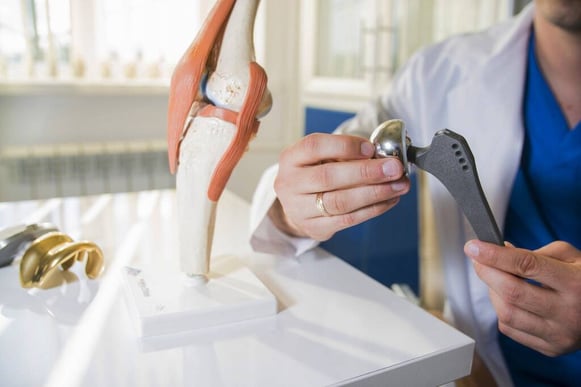
Is there a joint replacement surgery on the horizon for you? Are you currently suffering from the pain and challenges of arthritis? If so, you may want to consider occupational therapy as one way to help you adapt to your situation.
Occupational therapy can be an integral part of the patient’s rehabilitation after a joint replacement surgery and throughout the treatment of arthritis. Your doctor or surgeon may recommend that you make occupational therapy part of the rehabilitation. Occupational therapists can work as part of a multidisciplinary care team to help patients through the recovery journey.
The role of the occupational therapist is to assist patients in managing and overcoming limitations due to their condition or injury. By helping the patient to work and live independently and to improve their well-being, occupational therapists help patients achieve a better quality of life. The therapist will assess the lifestyle that the patient had prior to the surgery or illness, as well as expectations for post-surgery abilities. Many times, the therapist will consult with the family of the patient, the orthopedic surgeon in charge of the surgery, and other physicians to develop a program to best suit the patient’s expectations.
The Benefits of Occupational Therapy for Joint Replacement Surgery
Before we delve into the benefits of occupational therapy, it’s helpful to discuss what exactly joint replacement surgery is and why someone would need it.
According to the American Academy of Orthopedic Surgeons, total joint replacement is “a surgical procedure in which parts of an arthritic or damaged joint are removed and replaced with a metal, plastic, or ceramic device called a prosthesis.” You may have heard of common joint replacement surgeries such as hip and knee replacements.
People might need joint replacement surgery for various reasons. Often, surgery is needed because of arthritis, a fracture, or another medical condition. The actual surgery will take a few hours, but the pain and discomfort from the new joint might last a few months. The patient’s muscles will have to adjust to the new joint as they resume normal activities and movements.
It’s after the surgery where the benefits of occupational therapy really make a difference. During the rehabilitation period, occupational therapists help patients who have had a joint replacement adjust to living independently post-operation. After joint replacement surgery, patients may have trouble performing many of the activities of daily living that made it possible to function easily in everyday life and be independent members of society.
For example, patients who have had knee replacement surgery may have trouble standing, walking, or bending. Patients who have had hip replacement surgery may have trouble sitting up in bed. These limitations make it challenging to participate in life as they would normally do. During the recovery journey, occupational therapists can help patients with activities such as bathing and dressing, working, and socializing by teaching strategies and setting up their environment for success.
The occupational therapist’s responsibilities include:
- Conducting an initial evaluation of the patient’s physical capabilities and psychosocial needs after the joint replacement surgery
- Assessing what activities patients need and want to do and prioritizing them
- Teaching patients a variety of strategies for modifying activities
- Modifying the patient’s environment to make certain activities possible
The goal of occupational therapy after joint replacement surgery is to gradually achieve maximum functioning for the patient with the new joint while maintaining safety.
The Benefits of Occupational Therapy for Arthritis
According to the American Occupational Therapy Association, arthritis is joint inflammation that may affect one or more joints in the body. Arthritis leads to swelling and stiffness around the joints that can make it painful to move and do various things. Two common types of arthritis are osteoarthritis and rheumatoid arthritis. One in five adults in the U.S. are affected with arthritis, and the prevalence of the condition will increase to 67 million by 2030.
The occupational therapist’s role involves managing arthritis through various interventions. How can patients with arthritis feel less pain, feel less fatigue, and protect their joints? Physical therapy for arthritis is one part of the equation, while occupational therapy is another.
As with any occupational therapy program, the OT will first evaluate the patient’s current conditions, such as range of motion, strength, endurance, and severity of pain. Then the OT will create a plan of intervention that may include teaching skills and strategies, using adaptive equipment, and modifying the environment to help manage the challenges of arthritis and prevent it from getting worse.
For arthritis, an occupational therapist can:
- Recommend adaptive equipment to put less stress on your joints, including orthotic devices
- Evaluate your home to recommend modifications or adaptive equipment to help you carry out the activities of daily living
- Use heat and cold to reduce pain around your joints
- Introduce ways to support your joints while you are doing activities or resting
- Teach you special techniques to make critical movements easier and less painful
- Train you on how to conserve energy and avoid overuse of your joints
- Help you with exercises that improve range of motion, strength, and endurance
It’s important to note that while patients with arthritis may find it difficult to move the parts of their bodies that are affected by joint inflammation, the lack of movement may lead to the arthritic condition becoming worse. That’s why it’s important to be active and find effective ways to move---this can be achieved through occupational therapy in addition to physical therapy for arthritis.
The best time to see an occupational therapist for arthritis is immediately after you receive the diagnosis. However, occupational therapy can help at any time, especially since chronic conditions like arthritis change over time. Early intervention will make a difference in the treatment of the condition and help patients adapt to a medical issue that makes daily life more challenging.
The team at Rehab Select is experienced in helping patients with joint issues and arthritis recover and regain control of their lives. Learn more about occupational therapy at Rehab Select by scheduling a tour.




